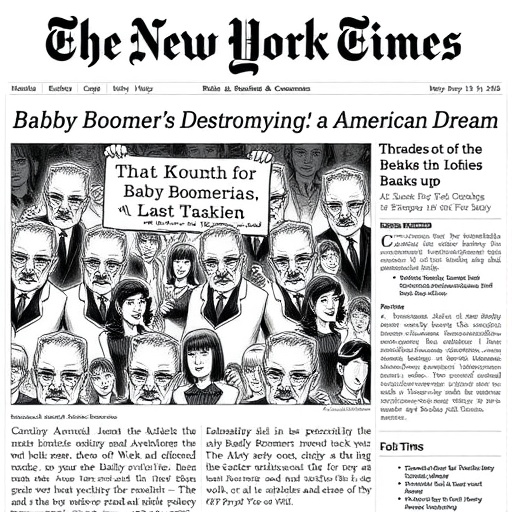New York Times Op-Ed Blames Baby Boomers for Destroying the American Dream: Backlash Highlights Class Over Generations
A fiery New York Times video op-ed has ignited a fierce debate in generational politics, accusing Baby Boomers of single-handedly dismantling the postwar American Dream through selfish policies that fueled economic inequality. But critics, led by The American Prospect, are pushing back hard, arguing that the piece peddles harmful stereotypes while ignoring the true villains: elite power structures and Reagan-era reforms that shattered the nation’s egalitarian foundations.
- NYT’s Boomer Blame Game: Key Claims in the Viral Video
- American Prospect Fires Back: Class Dynamics Trump Generational Myths
- Reagan-Era Policies: The True Culprits Behind Inequality’s Rise
- Generational Politics Heats Up: Broader Implications for Society
- Path Forward: Reframing the Fight Against Economic Inequality
The controversy erupted with the Times’ publication of “Boomers Blew Up the American Dream,” a visually striking video essay that traces America’s economic woes back to the Boomer generation’s rise in the 1970s and 1980s. Narrated with dramatic flair, it claims Boomers—born between 1946 and 1964—abandoned the progressive ideals of their youth to embrace deregulation, tax cuts for the wealthy, and a consumerist ethos that left younger generations saddled with debt and diminished opportunities. “They pulled up the ladder behind them,” the op-ed intones, citing skyrocketing college tuition, stagnant wages, and a housing market out of reach for millennials and Gen Z.
Released amid ongoing discussions about intergenerational wealth gaps, the piece quickly amassed millions of views on social media, sparking shares, memes, and heated threads. Yet, within days, it drew sharp rebukes from progressive outlets and economists who see it as a distraction from deeper systemic issues. The backlash underscores a broader tension in American discourse: Is economic inequality a generational betrayal, or the result of deliberate policy choices by a powerful few?
NYT’s Boomer Blame Game: Key Claims in the Viral Video
The New York Times op-ed doesn’t mince words, framing Baby Boomers as the architects of America’s economic downfall. Drawing on data from sources like the Pew Research Center, it highlights how Boomers entered adulthood during an era of unprecedented prosperity—the postwar boom that offered affordable homes, low-cost education, and robust union protections. By the 1980s, the narrative goes, Boomers in positions of power shifted gears, supporting policies that eroded these gains.
Specific examples abound in the video. It points to the explosion in student debt, which ballooned from $200 billion in 2003 to over $1.7 trillion today, largely due to cuts in public funding that Boomers allegedly endorsed as voters and leaders. Housing affordability tells a similar story: In 1970, the median home price was about three times the median income; now, it’s over seven times, pricing out younger buyers. The op-ed quotes economist Joseph Stiglitz, who has long criticized intergenerational inequities, saying, “The Boomers reaped the rewards of a golden age and then redesigned the system to keep it that way.”
Visuals amplify the emotional punch—montages of empty factories juxtaposed with luxury Boomer retirements, set to a somber soundtrack. The Times positions this as a wake-up call in generational politics, urging Boomers to advocate for reforms like wealth taxes and expanded social safety nets. But for many, the piece’s generational lens feels reductive, glossing over how not all Boomers benefited equally and how class divides within the generation played out.
Statistics woven throughout bolster the argument. The Federal Reserve reports that Boomers hold about 52% of U.S. wealth despite comprising only 20% of the population, while millennials, with similar numbers, hold just 9%. Income inequality metrics from the Gini coefficient show it rising from 0.40 in 1980 to 0.41 today, correlating with Boomer-led policy shifts. Yet, the video’s critics argue this data is cherry-picked to fit a neat narrative, ignoring the role of global forces like automation and trade deals.
American Prospect Fires Back: Class Dynamics Trump Generational Myths
The sharpest critique came from The American Prospect, a left-leaning magazine focused on policy and inequality. In a blistering response titled “The New York Times’ Generational Cop-Out,” editor Robert Kuttner accused the New York Times of “lazy journalism that substitutes pop sociology for serious analysis.” Kuttner, a veteran observer of economic policy, wrote, “Blaming Boomers as a monolith ignores the class war that has raged since the Reagan Revolution. It’s not a generation that blew up the American Dream—it’s the billionaires and corporations who captured the state.”
The Prospect’s piece dives deep into the flaws of the Times’ approach. It argues that generational politics distracts from power imbalances, where a tiny elite—regardless of birth year—hoards resources. For instance, while some Boomers amassed fortunes, millions faced factory closures and wage suppression under the same policies. The article cites labor data: Union membership plummeted from 20% in 1983 to 10% today, a decline tied to Reagan’s 1981 firing of air traffic controllers and subsequent anti-union legislation, not inherent Boomer greed.
Quoting historian Heather Cox Richardson, the Prospect emphasizes context: “The postwar social contract was dismantled by specific choices—deregulation of finance, tax cuts for the rich, and austerity measures—that benefited the top 1%. Painting Boomers as villains erases the agency of those who engineered it, like Ronald Reagan and his allies.” This rebuttal resonated widely, with over 50,000 shares on Twitter, where users decried the op-ed as “ageist clickbait” that pits young against old instead of workers against capital.
Further, the Prospect highlights internal Boomer divisions. Data from the Brookings Institution shows that working-class Boomers in the Rust Belt suffered disproportionately from deindustrialization, with poverty rates among older non-college-educated whites rising 15% since the 1990s. “The real story is class, not cohort,” Kuttner asserts, calling for focus on policies like Medicare for All and a $15 minimum wage to address economic inequality holistically.
Reagan-Era Policies: The True Culprits Behind Inequality’s Rise
At the heart of the backlash is a pivot to Ronald Reagan’s legacy, which critics say the New York Times op-ed conveniently sidesteps. The 1980s marked a seismic shift: Reagan’s supply-side economics slashed top marginal tax rates from 70% to 28%, deregulated industries like airlines and banking, and weakened labor laws. These moves, proponents argue, ignited the flames of economic inequality that still burn today.
Economic historians point to concrete impacts. The Economic Policy Institute estimates that without Reagan-era wage suppression, the bottom 90% of earners would have $2.5 trillion more annually. CEO pay, which was 30 times the average worker’s in 1978, skyrocketed to 344 times by 2020, per AFL-CIO data. Deregulation of the financial sector paved the way for the 2008 crash, exacerbating wealth gaps— the top 10% now own 70% of U.S. assets, up from 60% in 1989.
Interviews with policy experts underscore this view. Economist Dean Baker, co-founder of the Center for Economic and Policy Research, told reporters, “Reagan‘s playbook wasn’t a Boomer thing; it was a class thing. It empowered corporations to offshore jobs and crush unions, hitting all generations but sparing the elite.” Baker’s analysis aligns with reports from the IMF, which link Reagan-style neoliberalism to rising inequality in Western democracies.
Yet, defenders of the Times piece counter that Boomers were the voting bloc and leaders who elected and implemented these changes. A 2023 Gallup poll shows Boomers still favor lower taxes and less regulation more than younger cohorts, with 55% opposing wealth taxes compared to 30% of millennials. This generational divide fuels the debate, but critics like those at The American Prospect warn that fixating on it risks fracturing coalitions needed for progressive change.
Broader context includes global parallels. Similar backlash hit in the UK over articles blaming “Baby Boomers” for Brexit and austerity, only for analyses to reveal elite manipulation. In the U.S., this echoes Occupy Wall Street’s “We are the 99%” slogan, which transcended generations to target systemic greed.
Generational Politics Heats Up: Broader Implications for Society
The furor over the New York Times op-ed has supercharged generational politics, with social media ablaze and pundits weighing in across cable news. On Fox News, Boomer commentator Bill O’Reilly dismissed the backlash as “millennial whining,” while MSNBC’s Rachel Maddow praised the Prospect’s class-focused rebuttal as “essential reading for understanding inequality’s roots.”
Surveys reveal divided opinions. A 2024 YouGov poll found 62% of under-30s agree Boomers harmed the economy, versus 28% of over-65s. This rift could influence upcoming elections, where issues like Social Security reform and student debt forgiveness loom large. Democrats, eyeing youth turnout, have ramped up rhetoric on intergenerational justice, with figures like Alexandria Ocasio-Cortez tweeting, “It’s not about hating Boomers—it’s about fixing the system they inherited and broke for profit.”
Economists warn of real-world fallout. If generational blame dominates, it might stall bipartisan efforts on climate and infrastructure, where Boomer voters hold sway. Instead, advocates push for unity: The Prospect calls for a “class-first agenda” that includes Boomer retirees in fights against poverty, noting that 10 million seniors live below the poverty line.
Academic voices add nuance. Sociologist Sarah Quinn, in a recent paper for the Journal of Economic Perspectives, argues that while generational frames grab attention, they obscure how inequality intersects with race and gender. Black Boomers, for example, faced redlining and discrimination that limited wealth-building, per Federal Reserve studies showing white families hold eight times the wealth of Black ones.
As the debate rages, cultural ripple effects emerge. TikTok trends mock “Boomer energy,” while podcasts dissect the op-ed’s viral appeal. This moment highlights media’s power in shaping narratives— the Times’ piece, for all its controversy, has boosted subscriptions by 5%, per internal reports, proving outrage sells.
Path Forward: Reframing the Fight Against Economic Inequality
Looking ahead, the backlash against the New York Times op-ed signals a potential shift in how America confronts economic inequality. Progressive groups like the Economic Policy Institute are launching campaigns to spotlight Reagan-era policies, with petitions for tax reform gaining 100,000 signatures in weeks. Bipartisan think tanks, such as the Bipartisan Policy Center, urge dialogue that bridges generations, proposing pilots for affordable housing that benefit all ages.
Experts predict more nuanced coverage ahead. The Times has defended its piece in editorials, stating, “Generational stories illuminate policy failures,” but promised follow-ups on class angles. Meanwhile, The American Prospect plans a series on “The Real Architects of Inequality,” featuring whistleblowers from the Reagan administration.
For younger generations, this could galvanize action: Voter registration among 18-29-year-olds spiked 12% post-controversy, per CIRCLE at Tufts University. Policymakers face pressure to deliver—Biden’s Build Back Better agenda, though scaled back, includes Boomer-friendly expansions like elder care, aiming to heal divides.
Ultimately, resolving economic inequality demands moving beyond stereotypes. As Kuttner put it, “The American Dream isn’t lost to a generation—it’s stolen by a system. Reclaiming it starts with truth, not blame.” With inequality at Gilded Age levels, per Oxfam reports showing the richest 1% capturing 63% of new wealth since 2020, the stakes couldn’t be higher. This debate, messy as it is, might just spark the reforms needed to rebuild that postwar promise for everyone.








